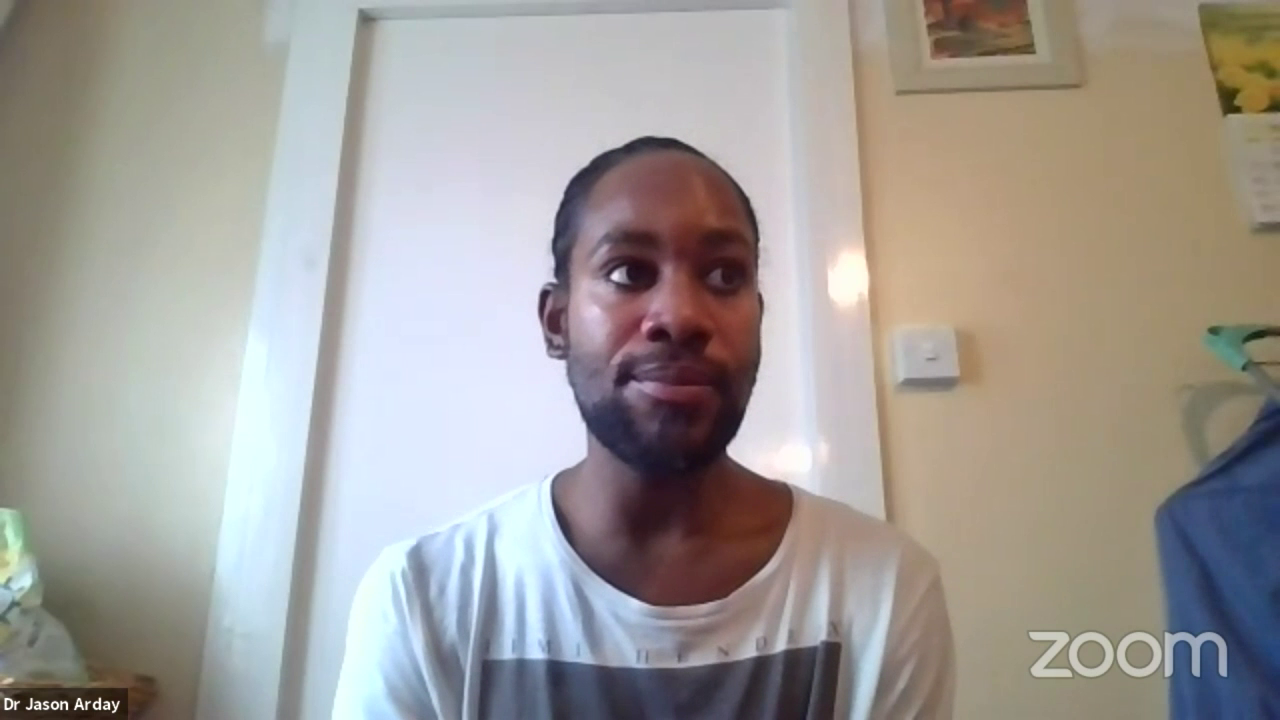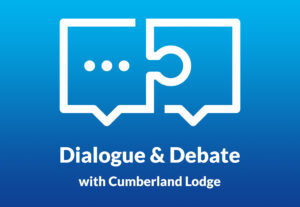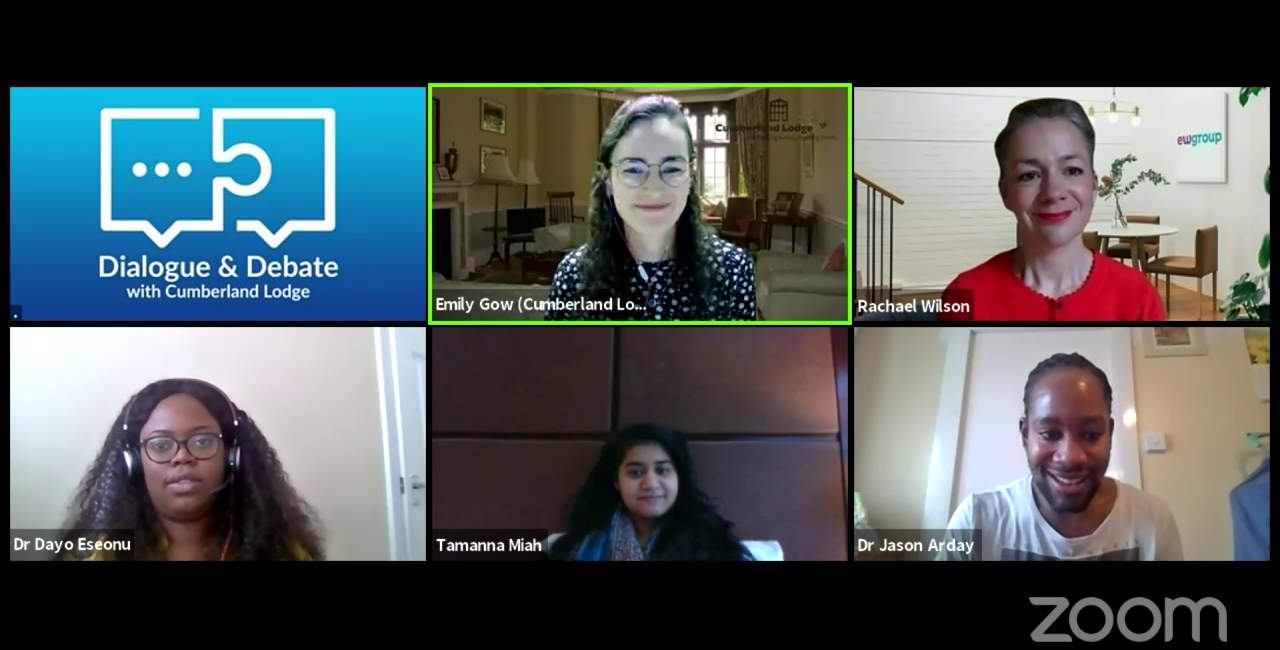In multicultural and multinational societies, like the UK, it is important for diversity to be fairly represented in the workplace and in education. To address this topic and to discuss several approaches towards improving diversity and inclusion practices, on Wednesday 3 November 2021, Cumberland Lodge hosted an interactive Dialogue and Debate webinar.
The discussion was hosted by Programme Officer Emily Gow, with four guest panellists:
- Dr Jason Arday – Associate Professor in the Department of Sociology, Durham University
- Dr Dayo Eseonu – Principal Researcher, The Young Foundation; Trustee, Involve
- Tamanna Miah – Campaigner, media spokesperson and Champion for the Young Trustees Movement
- Rachael Wilson – Managing Director, EW Group.
Kickstarting the webinar, the audience took part in a live poll. The question was: ‘would you be prepared to call out tokenism or a lack of meaningful inclusion in your workplace, educational institution, or in the public sphere?’. Interestingly, 72% of respondents answered yes, 3% said no, while 24% were unsure.
Diversity and how tokenism can become a detrimental action
Emily asked Dr Arday to define diversity, to which he said ‘it is embracing and recognising difference across the intersections’. He expressed his upset towards other definitions including ‘to tolerate people and difference’, since the word ‘tolerate’ means to resist in the first place.
The panel then exchanged views on diversity and tokenism. Dr Arday observed that tokenism is not yet applied efficiently, and that our ‘meritocratic system’ doesn’t work in the interest of people who belong to one, or several, minority groups. Dr Eseonu proved in her research that most people who progress into senior management roles are White males. Tamanna also stated the lack of diversity in the charity field. Charity trusteeship continues to be dominated by people who are senior and wealthy, and less than 3% of trustees are under the age of 30. Despite having less experience, young trustees can acquire additional professional skills through training sessions and workshops, and they can also bring creativity, value and fresh thinking on issues.
Dr Eseonu and Rachel didn’t support tokenism, expressing that it can have a negative impact on the inclusion of the minority when there is still a noticeable discriminatory and exclusionary behaviour in the workplace. According to Dr Eseonu, when you are the only ‘different’ one in the workplace, it can be stressful to adapt, and you may end up feeling isolated or marginalised. Rachel further challenged the practice of tokenism, saying it is not enough to achieve meaningful inclusion and equity; poor retention of staff, low staff engagement and difficult networking are indicators that tokenistic recruitment in isolation is not a sustainable solution.
Ways to promote inclusive diversity in the workplace
The panel suggested solutions to improve inclusion for minority groups in the workplace, so that they don’t feel like a mere token hire. Rachel mentioned the importance of having an inclusive and welcoming culture so people from diverse backgrounds can contribute, be heard and stay engaged in the workplace. For better engagement, Rachel suggested bringing all parties, including minorities, into the conversation to contribute in the decision-making process. She also stressed that to achieve inclusive networking in the workplace, all people, including those from minority groups, should enjoy some kind of independence. Flexible working arrangements, reasonable adjustment for disability, and setting diversity goals and strategy are some effective approaches suggested by Dr Eseonu, based on her research findings. It was also mentioned how crucial it is to depend on internal inclusion initiatives, rather than external ones.
As for higher education, Dr Arday talked about existing positive practice, such as offering PhD studentships and creating job specifications to suit a wide variety of people. However, such actions should be sped up to make universities more reflective of our multicultural society. For example, out of 535 academic staff employed as “managers, directors or senior officials” in British universities in the 2018/19 academic year, only 25 identified as Asian, mixed or another ethnicity, while none were Black. Similarly, it was pointed out that trustee boards are still lacking diversity. In terms of establishing inclusion, Tamanna stated that work and processes should be consistently evaluated by people who span demographic groups, to make sure that a variety of perspectives drive decision-making. Moreover, she thinks that language can be a barrier to inclusion; words should be as simple, clear and jargon-free as possible when contacting others who may be new in the field.

Positive discrimination or positive action?
For Rachel, there is a big misconception that positive discrimination is considered as a positive action; when someone is hired based on their gender or ethnicity, they may not be qualified for the position. Meritocracy shouldn’t be compromised while promoting diversity and inclusion; however, positive actions like establishing equity rather than equality, and controlling where to advertise your job to increase diversity are welcomed. There are many examples of positive actions; Two Ticks disability scheme and campaigns like wisecampaign and women returners. Tamanna added that minorities should be more aware of, and open to, joining different fields. She gave examples including the Jo Cox Women in Leadership Programme, run by the Labour Party, and the Young Trustee Movement.
When Emily asked about the value of a quota system, which is in place in France, both Dr Eseonu and Rachel stressed that it is illegal in the UK and can lead to positive discrimination. On the other hand, Dr Arday supports positive discrimination, saying that, in the UK, positive actions are applied selectively, not in the interest of minorities, and job specifications may be set by people with discriminatory behaviour which is difficult for individuals to challenge. In such cases, positive discrimination, modelled by some American and South African practices, can be helpful.
What’s the solution?
The panellists shared the view that we need a systemic and holistic change within society, encompassing data, policy, procedure, and the lived experience of staff.
A member of the audience asked how to embed effective diversity and inclusion practices, and what is the difference between being and feeling included. The panel answers were:
- More accountability, regular evaluation of work plans and procedures, and a zero-tolerance approach against any exclusive behaviour are amongst the suggested steps to avoid talking shops.
- ‘Being included’ means ensuring that employees are included and heard, for example, meetings shouldn’t be held in pubs where employees who don’t want to be around alcohol cannot contribute. ‘Feeling included’ is based on internal perception.
The webinar ended with the panel’s concluding thoughts:
- Dr Arday affirmed the good use of positive action to benefit the minority groups.
- Being included is to have your voice heard in your workplace.
- Practice should be dependent on the context in which an organisation is working.
- Sharing experiences and being held accountable is important.
Personal reflections
Based on my experience, all previously mentioned positive actions, and even positive discrimination, are helpless if individuals are not welcoming of diversity. Diversity is an ethical principle that should be established in people’s minds in the first place. A prosperous society depends on having all societal categories efficiently represented in all fields. I also believe, as Tamanna mentioned, minority groups should be targeted with training courses and facilities to help them get the required skills to participate in any field. By doing this, diversity and inclusion can be easily achieved while keeping meritocracy in action.


